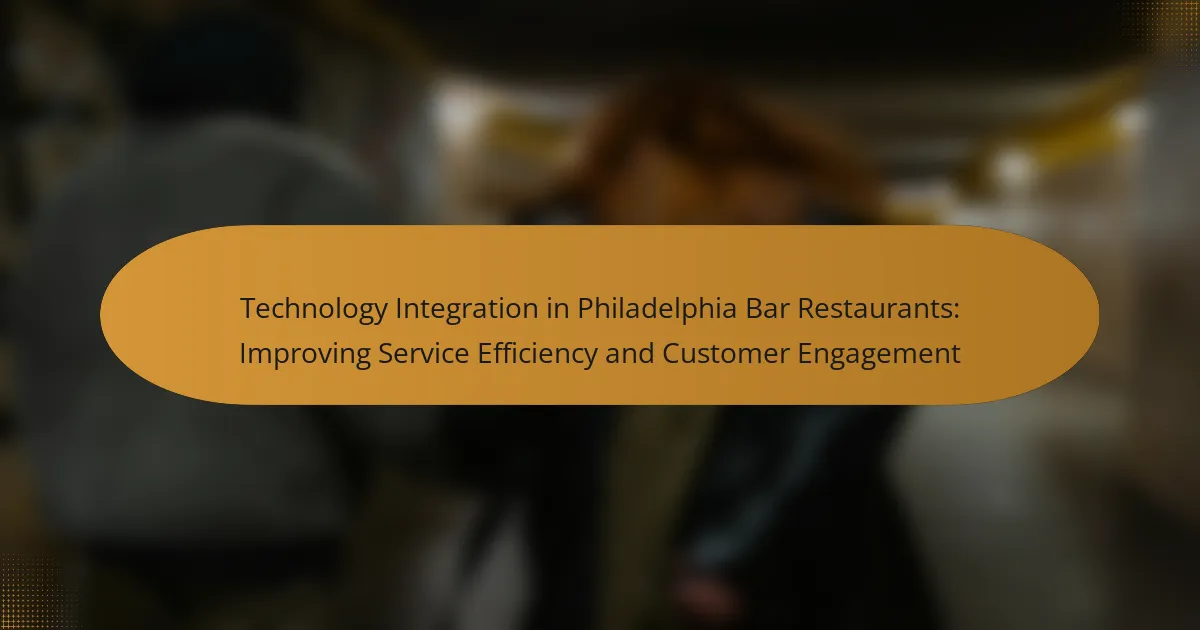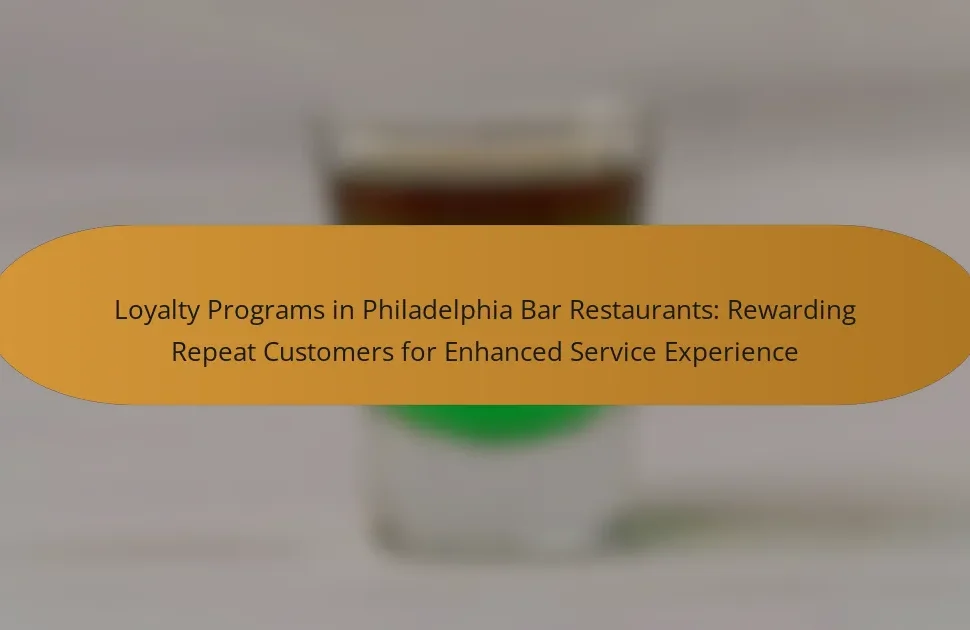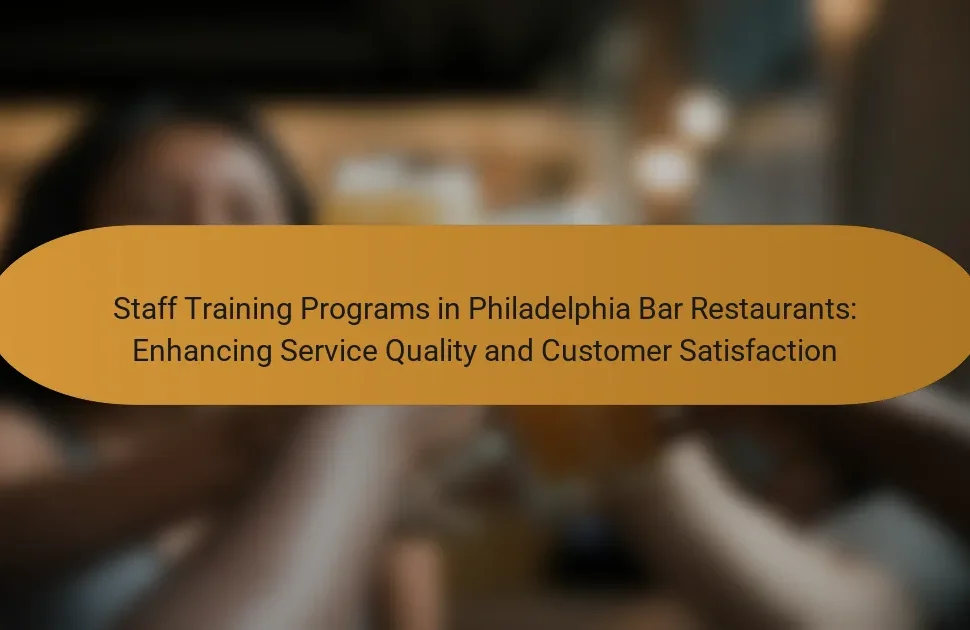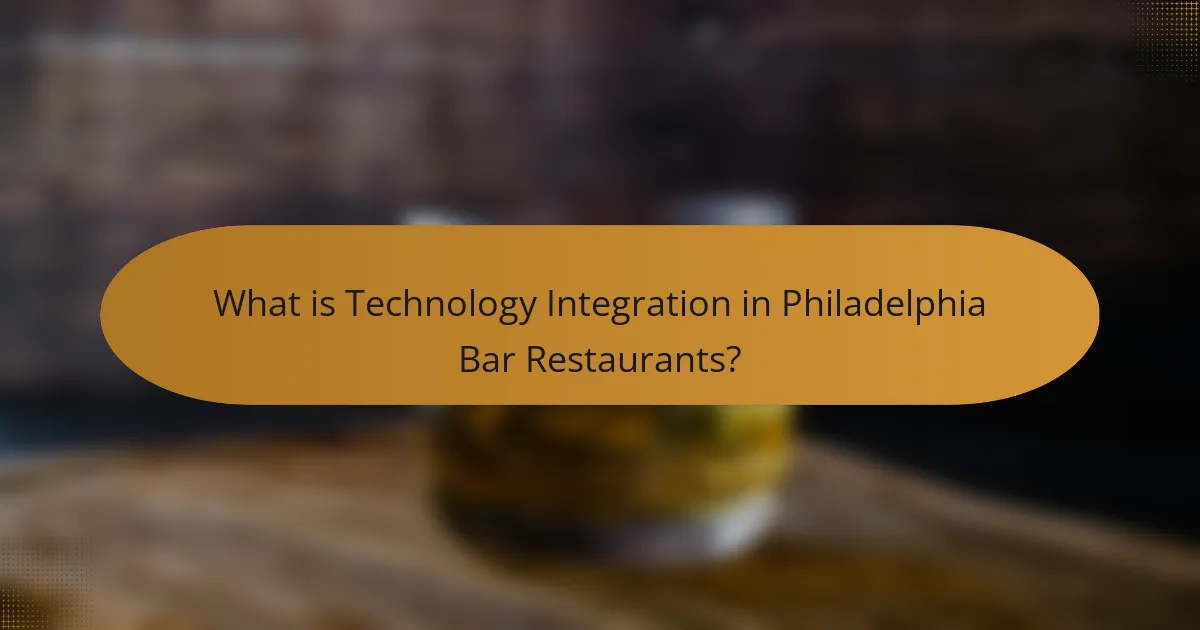
What is Technology Integration in Philadelphia Bar Restaurants?
Technology integration in Philadelphia bar restaurants refers to the incorporation of digital tools and systems to enhance operations. This includes point-of-sale systems, online reservations, and mobile ordering apps. These technologies streamline service processes and improve customer interactions. For instance, using tablets for orders can reduce wait times. Additionally, integrating customer relationship management systems allows bars to personalize marketing efforts. A survey by Toast found that 72% of restaurant owners believe technology improves efficiency. Overall, technology integration is key to modernizing bar restaurant operations in Philadelphia.
How does technology integration impact service efficiency in bar restaurants?
Technology integration significantly enhances service efficiency in bar restaurants. It streamlines operations through automated ordering systems. These systems reduce wait times for customers. Staff can focus on service rather than manual order taking. Inventory management software helps track stock levels in real-time. This minimizes waste and ensures popular items are always available. Data analytics provide insights into customer preferences. This allows for tailored promotions and improved menu offerings. A study by the National Restaurant Association found that technology can increase overall sales by up to 20%. Thus, technology integration directly correlates with improved service efficiency in bar restaurants.
What types of technologies are commonly integrated in bar restaurants?
Bar restaurants commonly integrate point-of-sale (POS) systems, digital menus, and inventory management software. POS systems streamline order processing and payment transactions. Digital menus enhance customer experience with interactive features. Inventory management software helps track stock levels and reduce waste. Additionally, bar restaurants often use customer relationship management (CRM) tools to personalize marketing efforts. These technologies collectively improve service efficiency and customer engagement.
How do these technologies streamline operations in bar restaurants?
Technologies streamline operations in bar restaurants by enhancing efficiency and improving service delivery. Point-of-sale systems automate order processing, reducing wait times. Inventory management software tracks stock levels in real-time, minimizing waste. Mobile ordering applications allow patrons to place orders from their tables, increasing table turnover. Staff scheduling tools optimize employee shifts, ensuring adequate coverage during peak hours. Customer relationship management systems gather data on preferences, enabling personalized service. According to a study by the National Restaurant Association, technology adoption can lead to a 20% increase in operational efficiency. These advancements collectively contribute to a smoother workflow and better customer experiences.
What role does technology play in enhancing customer engagement in bar restaurants?
Technology significantly enhances customer engagement in bar restaurants. It facilitates seamless communication between customers and staff. Online reservation systems allow customers to book tables easily. Mobile apps provide menus and enable ordering from smartphones. Social media platforms engage customers through promotions and events. Customer feedback tools gather insights for service improvement. Digital loyalty programs incentivize repeat visits. These technological advancements create a more interactive and personalized dining experience.
What are the most effective technology tools for customer engagement?
The most effective technology tools for customer engagement include customer relationship management (CRM) systems, chatbots, and social media platforms. CRM systems help businesses manage customer interactions and data throughout the customer lifecycle. They enhance customer service and drive sales growth. Chatbots provide instant responses to customer inquiries, improving response times and availability. Social media platforms allow businesses to engage with customers directly, fostering community and brand loyalty. According to a report by Salesforce, 70% of consumers say connected processes are very important to winning their business. This highlights the impact of technology tools on customer engagement.
How do these tools influence customer satisfaction and loyalty?
Technology tools enhance customer satisfaction and loyalty in bar restaurants. These tools streamline service delivery, reducing wait times. Faster service leads to a more enjoyable dining experience. Enhanced communication through apps allows customers to provide feedback instantly. This responsiveness fosters a sense of value among patrons. Personalized marketing through data analytics targets customer preferences effectively. Studies show that personalized experiences increase customer retention rates. For instance, a report by McKinsey found that 71% of consumers expect companies to deliver personalized interactions. Overall, technology tools create a more efficient and engaging environment, directly impacting customer satisfaction and loyalty.
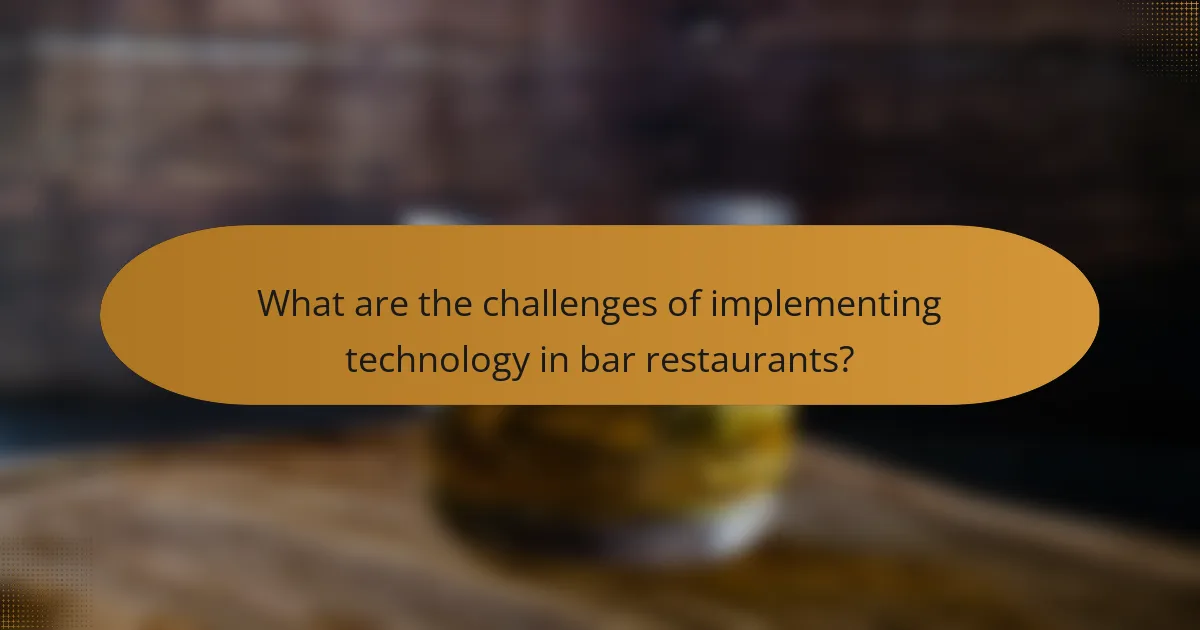
What are the challenges of implementing technology in bar restaurants?
The challenges of implementing technology in bar restaurants include high initial costs, staff training requirements, and integration issues. High initial costs can deter owners from adopting new systems. Staff training is essential for effective use of technology. Many employees may resist changes to established workflows. Integration with existing systems can be complex and time-consuming. Technical issues can disrupt service and lead to customer dissatisfaction. Additionally, ongoing maintenance and updates require additional resources. These challenges can impact the overall efficiency and customer experience in bar restaurants.
What common obstacles do Philadelphia bar restaurants face during technology integration?
Philadelphia bar restaurants face several common obstacles during technology integration. Limited budget constraints can hinder investment in advanced systems. Staff resistance to change often slows down the adoption of new technologies. Training employees on new systems can be time-consuming and costly. Integration with existing systems may present technical challenges. Compliance with local regulations can complicate the implementation process. Additionally, inconsistent internet connectivity can disrupt operations and affect customer experience. These obstacles often result in delays and increased costs for bar restaurants attempting to modernize.
How can bar restaurants overcome these challenges?
Bar restaurants can overcome challenges by implementing advanced technology solutions. Utilizing point-of-sale (POS) systems enhances order accuracy and speeds up service. Mobile payment options improve customer convenience and reduce wait times. Online reservation systems help manage customer flow effectively. Integrating social media for promotions increases customer engagement and outreach. Training staff on new technologies ensures smooth operation and better service. Regularly updating technology keeps the establishment competitive in a rapidly evolving market. These strategies collectively enhance efficiency and customer satisfaction in bar restaurants.
What are the costs associated with technology integration?
The costs associated with technology integration include hardware, software, and training expenses. Hardware costs can range from $500 to $5,000 depending on the type of technology implemented. Software expenses typically vary from $20 to $300 per month based on subscription models. Training costs for staff can add an additional $1,000 to $3,000, depending on the complexity of the system. Maintenance and support fees may also apply, often around 15% of initial software costs annually. These costs can significantly impact the overall budget for technology integration in bar restaurants.
How can bar restaurants measure the success of technology integration?
Bar restaurants can measure the success of technology integration through key performance indicators (KPIs). These KPIs include increased sales, reduced wait times, and improved customer satisfaction scores. Tracking sales data before and after technology implementation provides clear insights into revenue changes. Monitoring average service times can reveal efficiency improvements. Customer feedback surveys can gauge satisfaction levels, highlighting areas of success or needed improvement. Additionally, analyzing staff productivity metrics can indicate how technology aids employee performance. Implementing these measurement strategies allows bar restaurants to assess the effectiveness of their technology integration accurately.
What key performance indicators (KPIs) should be tracked?
Key performance indicators (KPIs) that should be tracked include customer satisfaction scores, average order fulfillment time, and table turnover rate. Customer satisfaction scores reflect the quality of service and food, which is critical for retention. Average order fulfillment time measures the efficiency of service, impacting customer experience. Table turnover rate indicates how effectively a restaurant utilizes its space and serves customers. Tracking these KPIs helps identify areas for improvement and enhances overall operational efficiency.
How can customer feedback be utilized to assess technology effectiveness?
Customer feedback can be utilized to assess technology effectiveness by gathering insights directly from users. This feedback reveals how well the technology meets customer needs. Surveys and reviews can quantify satisfaction levels. Analyzing this data helps identify strengths and weaknesses in the technology. For instance, if customers report slow service due to a specific system, it indicates a need for improvement. Additionally, tracking changes in customer engagement can show the impact of technology changes. A study by the American Customer Satisfaction Index found that customer feedback directly correlates with technology performance. This proves that customer insights are crucial for evaluating and enhancing technology effectiveness.
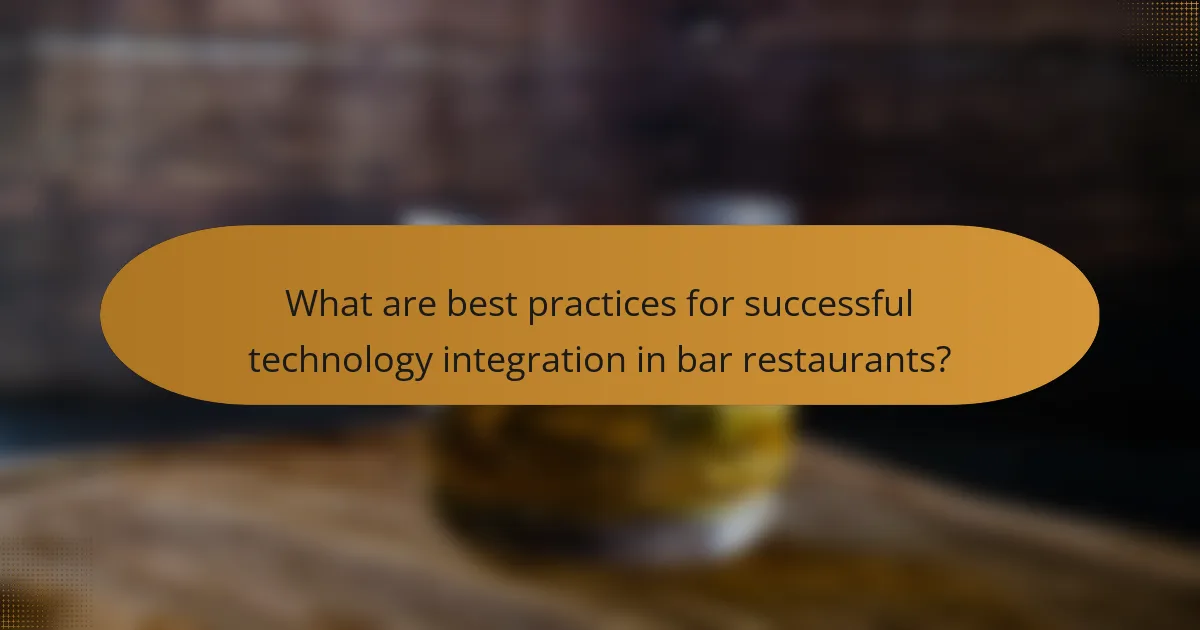
What are best practices for successful technology integration in bar restaurants?
Successful technology integration in bar restaurants involves several best practices. First, assess the specific needs of the establishment. Understanding operational pain points helps in selecting the right technology. Second, choose user-friendly systems that staff can easily adopt. Training employees on new tools is crucial for effective implementation. Third, ensure seamless integration with existing systems. Compatibility reduces disruptions and enhances efficiency. Fourth, prioritize customer engagement technologies. Solutions like mobile ordering and digital menus improve the dining experience. Fifth, regularly evaluate technology effectiveness. Gathering feedback from staff and customers can guide future improvements. Finally, stay updated on industry trends. Adopting innovative solutions can keep the bar competitive and relevant.
How can bar restaurants choose the right technology solutions?
Bar restaurants can choose the right technology solutions by assessing their specific operational needs. They should identify areas where technology can enhance efficiency, such as point-of-sale systems or inventory management. Researching various technology vendors is crucial to find solutions that align with their budget and requirements. Additionally, evaluating user reviews and case studies can provide insights into the effectiveness of different systems. Conducting trials or demos of potential solutions allows bar restaurants to gauge usability and integration capabilities. Finally, ensuring that the chosen technology can scale with business growth is essential for long-term success.
What factors should be considered when selecting technology partners?
When selecting technology partners, businesses should consider several key factors. Compatibility with existing systems is crucial for seamless integration. The partner’s experience in the hospitality industry ensures they understand specific challenges. Scalability of technology is important for future growth and adaptability. Support and training services provided by the partner can enhance implementation success. Cost-effectiveness of the solution must align with budget constraints. Security measures should be robust to protect customer data. Lastly, the partner’s reputation and customer reviews provide insight into reliability and service quality.
How can staff training enhance technology adoption?
Staff training enhances technology adoption by equipping employees with necessary skills. Training programs familiarize staff with new tools and systems. Employees gain confidence in using technology effectively. This reduces resistance to change and encourages a positive attitude towards new processes. Research shows that organizations with comprehensive training see a 70% increase in technology usage. Training also promotes collaboration among staff, leading to better problem-solving. Ultimately, well-trained staff can leverage technology to improve service efficiency and customer engagement.
What practical tips can bar restaurants follow for effective technology integration?
Bar restaurants can follow several practical tips for effective technology integration. First, they should assess their specific needs and goals. This helps identify the right technology solutions. Next, investing in a reliable POS system is crucial. A good POS system streamlines transactions and inventory management. Staff training on new technologies is also essential. Well-trained staff can maximize the benefits of technology. Integrating online ordering systems enhances customer convenience. This can significantly increase sales and customer satisfaction. Additionally, utilizing customer relationship management (CRM) software helps in personalizing customer interactions. This can lead to improved customer loyalty. Lastly, regularly reviewing and updating technology ensures it meets evolving business needs. These practices collectively enhance service efficiency and customer engagement in bar restaurants.
How can bar restaurants ensure a smooth transition to new technologies?
Bar restaurants can ensure a smooth transition to new technologies by conducting thorough staff training. Training helps employees understand new systems and their functionalities. Clear communication about the benefits of the technology fosters acceptance. Implementing technology in phases allows for gradual adaptation. Gathering feedback from staff during the transition identifies areas needing improvement. Regular updates and support from management reinforce confidence in using new tools. According to a study by the National Restaurant Association, 73% of restaurant operators believe technology improves efficiency. This statistic highlights the positive impact of technology on operational performance.
What ongoing support is essential for maintaining technology systems?
Ongoing support essential for maintaining technology systems includes regular updates, monitoring, and troubleshooting. Regular updates ensure that software is secure and functions optimally. Monitoring involves tracking system performance to identify issues before they escalate. Troubleshooting addresses any problems that arise, minimizing downtime. Additionally, training staff on new technologies is vital for effective usage. Documentation of system processes aids in consistent maintenance. These practices collectively enhance system reliability and user satisfaction in bar restaurants.
Technology integration in Philadelphia bar restaurants involves the use of digital tools and systems to enhance operational efficiency and customer engagement. Key technologies include point-of-sale systems, online reservations, and mobile ordering apps, which streamline service processes and improve interactions with patrons. The article explores the impact of these technologies on service efficiency, customer satisfaction, and loyalty, while also addressing challenges such as costs, staff training, and integration issues. Best practices for successful technology adoption and methods for measuring effectiveness are also discussed, providing a comprehensive overview of how technology can modernize bar restaurant operations in Philadelphia.
